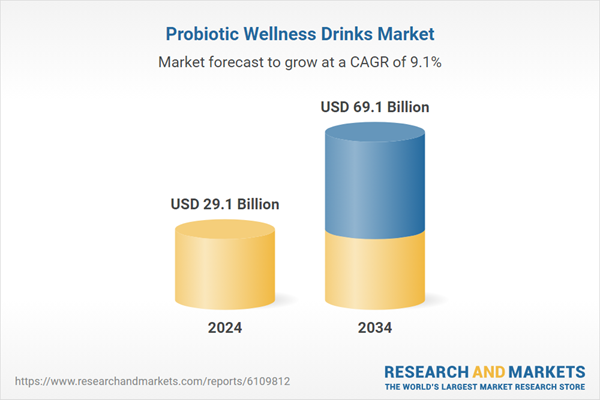Surging interest from millennials and Gen Z, combined with increased access through e-commerce and retail, is driving market momentum. Flavor innovation added functional benefits like hydration and energy, and targeted health outcomes continue to shape market growth. Additionally, rising disposable incomes, health-conscious urban populations, and growing influence from healthcare endorsements are expanding the customer base in developing regions. The global market is being driven not only by scientific backing and brand investment but also by increasing demand for sustainable, clean-label drinks that align with wellness and environmental values.
The Kombucha segment held a share of 28.6% in 2024, generating USD 8.3 billion. Its popularity stems from its status as a naturally fermented tea known for its probiotic benefits, clean ingredients, and refreshing taste. The segment continues to expand as younger consumers embrace new flavor innovations like berry medleys, ginger infusions, and lower-alcohol versions. Its adaptability into the wellness lifestyle space and broad appeal among health-conscious consumers have fueled growth and loyalty within this category.
The retail distribution segment led the global market in 2024, accounting for 52.6% and generating USD 15.3 billion. This dominance is attributed to the widespread availability of probiotic drinks in health food stores, supermarkets, hypermarkets, and specialty retail outlets. These formats offer accessibility, brand visibility, and impulse-buy potential, boosting overall sales volumes. Retail settings provide a physical platform where consumers can compare options, discover promotions, and try new formats, which continues to reinforce their market position.
Asia Pacific Probiotic Wellness Drinks Market held a 35.2% share in 2024. This leadership is rooted in cultural familiarity with fermented beverages and rapidly modernizing health trends. Countries across the region - such as Japan, China, South Korea, and India - have historically consumed probiotic-rich drinks, laying the foundation for commercial growth. Rising urbanization, health awareness, and income levels, paired with growing online and physical retail infrastructure, are propelling adoption further.
Multinational players such as Danone S.A., Nestle S.A., Yakult Honsha Co. Ltd., GT’s Living Foods Group plc, and Kevita (PepsiCo) are expanding through regional partnerships and product localization strategies to serve diverse consumer segments across the region. Companies competing in the probiotic wellness drinks market are implementing a mix of innovation, personalization, and regional focus to maintain leadership.
Product development strategies focus on enhancing flavor variety, reducing sugar, and introducing plant-based alternatives to align with shifting health preferences. Firms are also prioritizing clean-label certifications and transparent sourcing to win consumer trust. Brand expansion in emerging markets is being achieved through localization, strategic alliances, and culturally tailored offerings. Investment in e-commerce platforms and omnichannel retail strategies are strengthening accessibility and consumer engagement.
Comprehensive Market Analysis and Forecast
- Industry trends, key growth drivers, challenges, future opportunities, and regulatory landscape
- Competitive landscape with Porter’s Five Forces and PESTEL analysis
- Market size, segmentation, and regional forecasts
- In-depth company profiles, business strategies, financial insights, and SWOT analysis
This product will be delivered within 2-4 business days.
Table of Contents
Companies Mentioned
- GT's Living Foods
- Danone S.A.
- Yakult Honsha Co., Ltd.
- Nestlé S.A.
- KeVita (PepsiCo)
- Health-Ade Kombucha
- Lifeway Foods, Inc.
- Culture Pop
- Poppi
- Biotiful Dairy
- Karma Probiotic Water
- Chr. Hansen Holding A/S
- DuPont Nutrition & Biosciences
- BioGaia AB
- Lallemand Inc.
Table Information
| Report Attribute | Details |
|---|---|
| No. of Pages | 220 |
| Published | June 2025 |
| Forecast Period | 2024 - 2034 |
| Estimated Market Value ( USD | $ 29.1 Billion |
| Forecasted Market Value ( USD | $ 69.1 Billion |
| Compound Annual Growth Rate | 9.1% |
| Regions Covered | Global |
| No. of Companies Mentioned | 15 |









